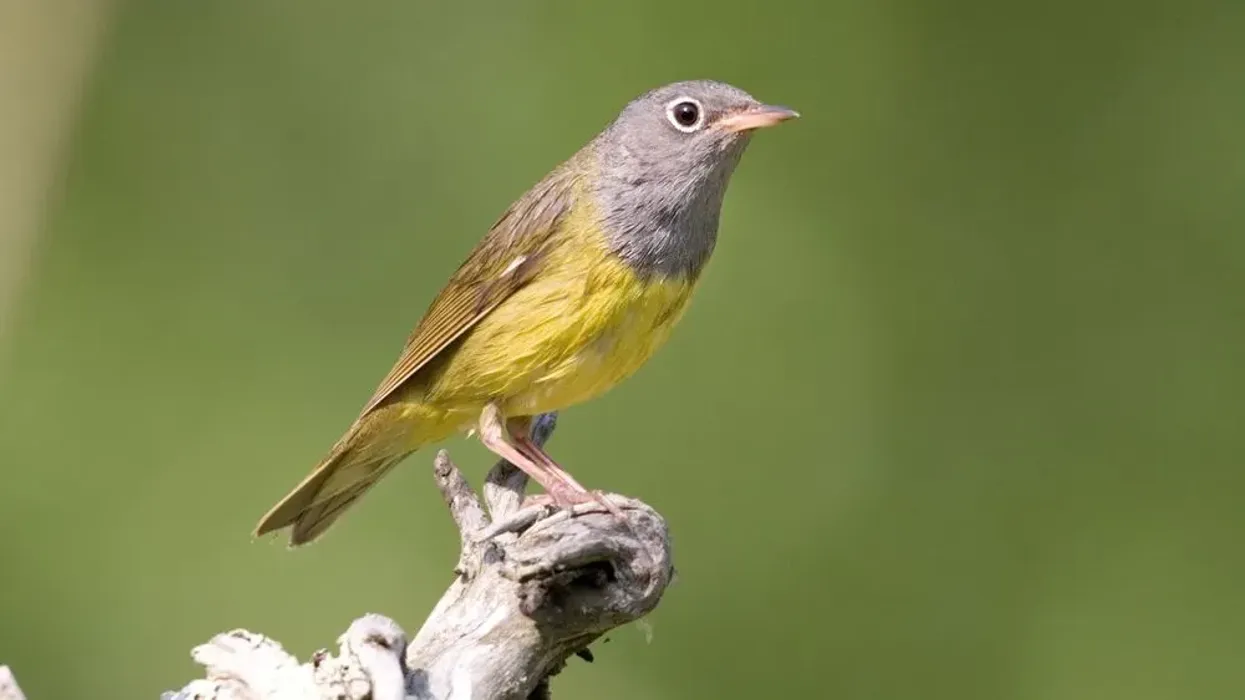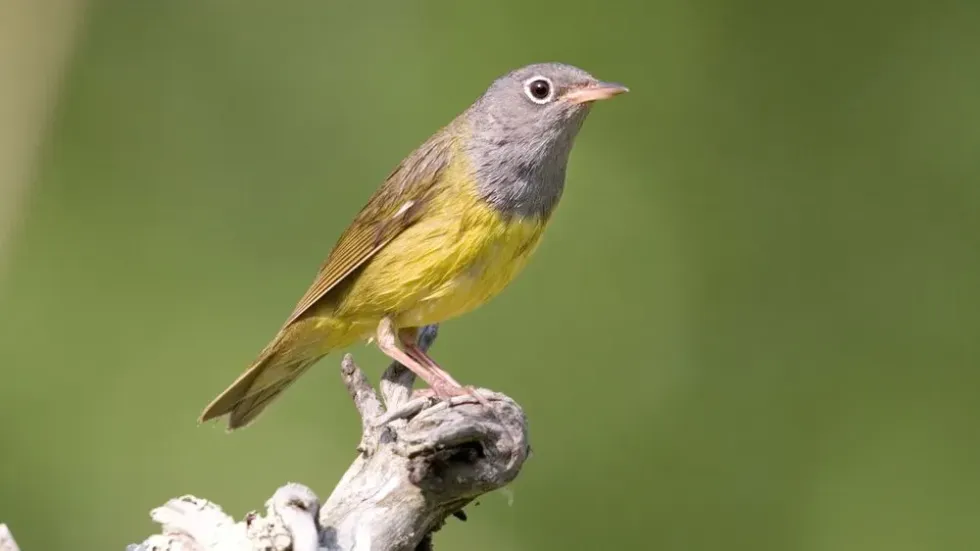The Connecticut warbler, Oporornis agilis is a type of North American warbler bird belonging to the New World warbler family. The Connecticut warbler is a very small songbird. It is classified in the order Passeriformes family Parulidae. Some species of warblers are extremely rare.
The Connecticut Warbler is a small bird that has an olive-gray upper part with a yellow underpart. There has not been extensive research on the bird given its preferred habitats.
Its behavior is to forage on the ground for food while bobbing their tails. They are a migratory bird species that migrate to South America. They are called so because of their resemblance to the Old World warblers.
The Connecticut warbler is not a frequent visitor to Connecticut. They are named after the location in which they were first spotted by Alexander Wilson. Their habitats are found mostly in North America. They are found in Spruce trees, Aspen trees, Poplar trees, and Tamarack forests.
Because of their habitats, they are not commonly sighted. There is also speculation that these North American birds are declining in number due to the loss of their habitats, specifically their wintering grounds. Unfortunately, some of their numbers are at conservation risk in Saskatchewan and Minnesota.
Included in this article is information such as Connecticut Warbler migration, Connecticut Warbler conservation status, Connecticut Warbler in Minnesota, health map of Connecticut Warbler, and so on.
You may also check out the fact files on Kentucky warblers and Nashville warblers from Kidadl.
Connecticut Warbler Interesting Facts
What type of animal is a Connecticut warbler?
The Connecticut warbler, Oporornis agilis, is a species of North American songbird belonging to the warbler family of birds.
What class of animal does a Connecticut warbler belong to?
The Connecticut warbler is classified under the class Aves, order Passeriformes, family Parulidae, and genus Oporonis.
How many Connecticut warblers are there in the world?
The Connecticut warbler is a mysterious bird of North America that does not have sufficient research about them. Fewer than 25,000 of the birds have been banded. There is no information about the actual number of birds in the world. However, there is speculation of a declining population due to loss of habitat and wintering grounds.
Where does a Connecticut warbler live?
The Connecticut warbler's nest is found mostly in bogs or open woods near water. They are found in poplar forests, spruce bogs, tamarack forests, or aspen forests. They are found mostly in thickets and undergrowth close to the ground, and wet woods during migration.
What is a Connecticut warbler's habitat?
Their habitat is usually in the range map of the United States, central Canada, and British Columbia. Their nesting habitats are wet woods, spruce, poplar, tamarack, aspen forests, thickets, and undergrowth. During migration, they leave their nest and usually travel to South America.
Who do Connecticut warblers live with?
Connecticut warblers are difficult to find. They are solitary by nature, but groups of about 25 birds come together before they begin the migration.
How long does a Connecticut warbler live?
There is not much research around the Connecticut warbler, but there are records of the oldest banded bird being four years and three months old.
How do they reproduce?
The breeding process begins with courtship. This starts as the migrant birds arrive on the breeding grounds. Males start to sing to court the females. Males are very territorial during this time of their nesting habitat. They defend their breeding range anywhere between 0.24 to 0.48 hectares.
Unlike some similar species, the Connecticut Warbler species are breeding birds that have only one brood per year. These birds like to make dense nests close to the ground concealed with moss where their eggs and young are safe from predators.
After courtship between the parents, around the spring and summer seasons, the females lay eggs around mid-June or July. The eggs are cream in color with spots of brownish hue on the shells. There is an incubation period where only the females incubate the eggs in the nest.
Baby birds or the young fledglings hatch in late July to August. Both male and female parents feed the young with berries, seeds, caterpillars, and larvae.
What is their conservation status?
It is presumed their conservation status is of Least Concern. The Connecticut warbler is an uncommon bird and known for skulking.
Skulking in the process of foraging for food close to the ground. Because of their preferred nesting habitat, there has been very little research to find out more about this species. However, their numbers are diminishing due to the rapid loss of their habitat, wintering grounds in places like Saskatchewan and Minnesota.
Connecticut Warbler Fun Facts
What do Connecticut warblers look like?

The Connecticut Warbler is a small songbird of North America. They measure about 5.1–5.9 in (13–15 cm) in length with a wingspan of 8.7–9.1 in (22–23 cm).
They weigh a small 0.033 lbs (15 g). Connecticut warblers have olive-gray upperparts with yellow underparts. They have pink legs, long tails, and a ring around their eyes. Males have gray hoods while females have brown whitish hoods. These birds also have small, pointed bills.
How cute are they?
The warbler bird family as a whole is quite cute. They are often multi-colored and small. The Connecticut warbler in specific also has a colorful body which adds to its cuteness. They also make many chirping sounds which add to their cuteness quotient.
How do they communicate?
Connecticut warblers are loud birds that have a range of vocalizations. They make chirping sounds in order to communicate with each other. But they are the loudest during the breeding season when the males sing to court the females.
How big is a Connecticut warbler?
The Connecticut warbler is a very small bird. They measure about 5.1–5.9 in (13–15 cm) in length, with a wingspan of 8.7–9.1 in (22–23 cm). They weigh a small 0.033 lbs (15 g).
For scale against similar species, the smallest of the warbler species is called Lucy’s warbler. It is about 1.1 in (3 cm) smaller and half the weight of the Connecticut warbler.
How fast can a Connecticut warbler fly?
There is little information available about this elusive species. Therefore the speed of their flight cannot be ascertained. During migration, they leave their nests after the breeding process, in August, and travel to South America in the fall. They eventually return to the breeding grounds the following year in the spring-summer season in May.
How much does a Connecticut warbler weigh?
The Connecticut warbler weighs 0.033 lbs (15 g).
What are the male and female names of the species?
The males and females of this species do not have a specific name based on their sex.
What would you call a baby Connecticut warbler?
Similar to other bird species, the baby of a Connecticut warbler is called a fledgling or a chick.
What do they eat?
Connecticut warblers are known for skulking. Skulking is a form of foraging closer to the ground in dense, low vegetation for food. They eat nuts, berries, small insects, caterpillars, snails, and spiders.
Are they dangerous?
Connecticut warblers are a solitary species that are uncommon. This population is not found in cities or in backyards. Given their size, Connecticut warblers are not dangerous to humans.
Would they make a good pet?
The natural habitat of Connecticut warblers is dense vegetation, bogs, undergrowth, and forests. They are not the type found in cities, so they would not make a good pet.
Did you know...
A collective group of Connecticut warblers is called a skulk or a Yankee of warblers.
While these birds are doing their yearly migration in the fall, they travel to many regions including Colombia, Venezuela, Guyana, and Peru. There have also been sightings at the Caribbean, Bermuda, St Thomas, St Martin, and the island of Hispaniola.
One of the common threats to these birds is human-made structures, for example, transparent windows, and pesticides.
How does a Connecticut warbler sound?
Connecticut warblers make many sounds, for example, 'cheepa cheepa', 'beecher beecher', and 'whippity-whippity-whip'.
What makes a bird a warbler?
The New World warblers family, to which the Connecticut warblers belong, are from the Parulidae family. Some ways to recognize the warblers are by their colors, plumage patterns, their voice, behavior, and habitats. They all have eye rings, stripes of color around or through the eye, stripes or marks on their bodies and wings.
Here at Kidadl, we have carefully created lots of interesting family-friendly animal facts for everyone to discover! Learn more about some other birds from our Altamira oriole facts and crested caracara facts pages.
You can even occupy yourself at home by coloring in one of our free printable connecticut warbler coloring pages.









